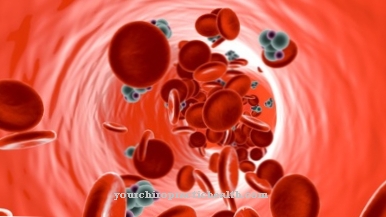With the Thermoregulation the human body maintains an environment-independent body temperature of 37 degrees Celsius. The metabolism as well as the muscles and the oxygen transport are dependent on this temperature. Thermoregulatory disturbances occur, for example, with heat stroke.
What is thermoregulation?

Thanks to thermoregulation, the human body temperature is relatively independent of outside temperatures. This means that humans are one of the equally warm living beings. This is to be distinguished from cold-blooded creatures whose body temperature changes significantly with the outside temperature.
In humans, thermoregulation corresponds to maintaining a constant core body temperature of around 37 degrees Celsius. The metabolism as well as the oxygen transport and the muscle activity are dependent on a constant temperature that corresponds to their optimal operating temperature.
To maintain the temperature, there is a permanent exchange between the human body and its environment. Convection, conduction, radiation and evaporation make up this exchange. Through these mechanisms, the organism can either lower or raise its temperature autonomously.
The center of thermoregulation is the hypothalamus, from which all the processes mentioned are initiated. The ambient and internal temperatures are permanently determined by so-called thermal cells in the skin and the mucous membrane and passed on to the hypothalamus.
Function & task
Thermoregulation is the prerequisite for various processes in the human organism. For example, increases in temperature increase the elastic properties of all muscles and tendons. The metabolic reactions in the human organism are just as temperature-dependent.
An increase in temperature increases the kinetic energy of the particles involved and makes a reaction more likely. Since the proteins in the human organism are denatured at temperatures of more than forty degrees, the ideal metabolic temperature is 37 degrees Celsius.
Both the enzyme reactions and the fluidity properties of the cell membranes and the diffusion or osmosis behavior in the organism are influenced by the kinetics of the particles, which in turn are determined by the temperature.
Temperatures also play a role in the transport of oxygen through the bloodstream. Hemoglobin gives the blood the ability to bind oxygen particles. The binding affinity decreases with falling temperatures, so that the oxygen transport can only take place at relatively warm temperatures. Without the oxygen transport, there would be tissue loss and ultimately death. Thermoregulation is therefore imperative for human life.
Body heat results from the energy conversion of the muscles and the metabolism. In the muscles, chemical energy becomes kinetic energy, which creates heat. The transport and distribution of this heat takes place by convection, which the blood has to the medium. The subcutaneous fatty tissue prevents heat loss, as with an insulating layer.
If the body temperature nevertheless drops due to extremely low outside temperatures, this loss is reported to the hypothalamus by the thermal cells. The brain then stimulates the pituitary gland, which releases the thyrotropin releasing hormone and thus increases the sympathetic tone. The heart rate increases due to the hormone, the metabolism is stimulated and the muscles provide more energy. In this way, the body temperature can be maintained despite the cold.
If, on the other hand, the body becomes too warm due to persistently high ambient temperatures, the hypothalamus lowers the sympathetic tone. This results in a peripheral vasodilatation and the blood circulation improves, so that a certain area is created for heat exchange. Heat is lost through convection. In addition, sweat secretion is stimulated because sweat glands are sympathetically innervated. Evaporation creates cold by evaporation, which cools the organism.
You can find your medication here
➔ Medicines for cold feet and handsIllnesses & ailments
Various medications, but also deficiency symptoms such as iron deficiency, cause disturbances in thermoregulation. These disorders usually correspond to inadequate sweating in cold ambient temperatures or shivering despite a warm temperature.
Such symptoms can also occur in the context of nervous system diseases such as polyneuropathies. A distinction must be made between pure sensory disorders in which only the sensation of warmth and cold is disturbed. This feeling is anyway subject to individual components. Real perceptual disorders in connection with the temperature often occur in the context of central nervous system injuries, which in turn can have various causes. A disturbed temperature perception does not have to be directly related to a disturbed thermoregulation.
Actual thermoregulatory disorders are usually caused by the hypothalamus or the sympathetic nervous system. If there is a lesion in one of the parts of the brain, this can cause dysregulation of the metabolism, but also of the muscles, which in turn have an effect on maintaining body temperature.
Thermoregulation can just as quickly fail in the event of symptoms such as heat stroke. There are different forms of heat stroke. In the severe variants of the phenomenon, heat damage occurs to the cells and sometimes even to the organs. The balance of thermoregulation is brought out of balance. Heat stroke, for example, is caused by increased heat production, which can occur in sports beyond all limits.
Failure to dissipate heat can also result in heat stroke. If a core temperature of more than 40 degrees Celsius is reached during this, the enzyme systems are damaged. The cells' energy stores are depleted and membrane permeability and sodium flow increase. The thermoregulatory mechanisms fail completely and the temperature continues to rise, which leads to necrosis and multiple organ failure.








.jpg)



















